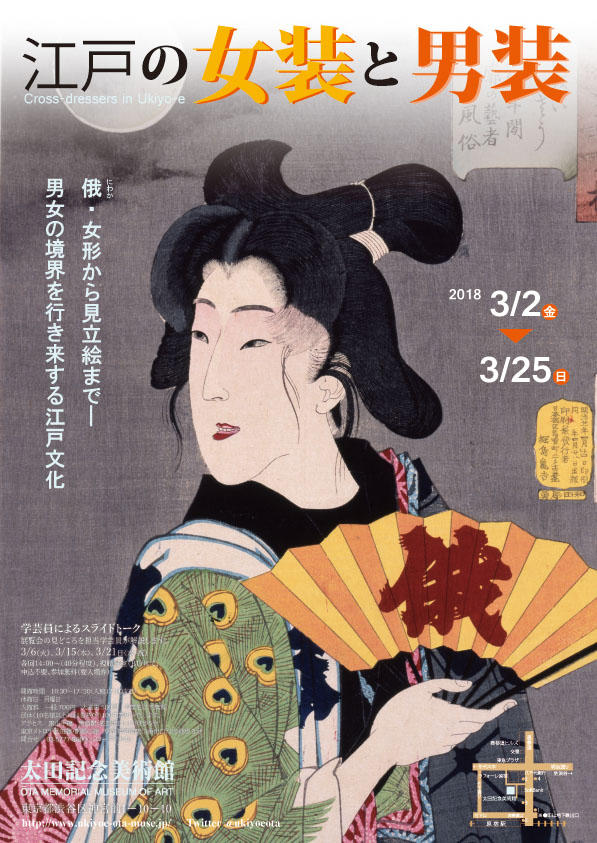江戸の女装と男装
男女の境界を行き来する江戸文化
女装や男装の文化は、洋の東西を問わず、古くから見られるものです。日本では、女装といえば『古事記』に見える、ヤマトタケルが女装して熊襲を退治した話が思い出されますし、また中世の稚児による女装、芸能に見られる女装など、古くから異性装の風俗がありました。 江戸時代にも祭礼で芸者などの女性が男装して出し物を演じたり、男性役者が女装して女性を専門に演じる歌舞伎の女形など、男装や女装の風俗が見られます。また、歌舞伎に登場する女装の盗賊、弁天小僧をはじめ、物語で活躍する異性装の登場人物も広く親しまれました。浮世絵では歴史や物語に登場する人物の男女を入替えて、当世風の人物に置き換えるやつし絵や見立絵も多く描かれています。 男女が入れ替わる趣向という意味では、近年の映画「君の名は。」の大ヒットも思い起こされるところですが、既に江戸時代には、異性装や男女を入れ替えるという発想が、庶民にとって身近なものであったことがうかがえます。本展では、描かれた浮世絵を通して、男女の境界を自由に行き来する江戸時代の風俗や文化の諸相に迫ります。

落合芳幾「獅子王二和賀全盛遊」
祭礼で男装する女性たち
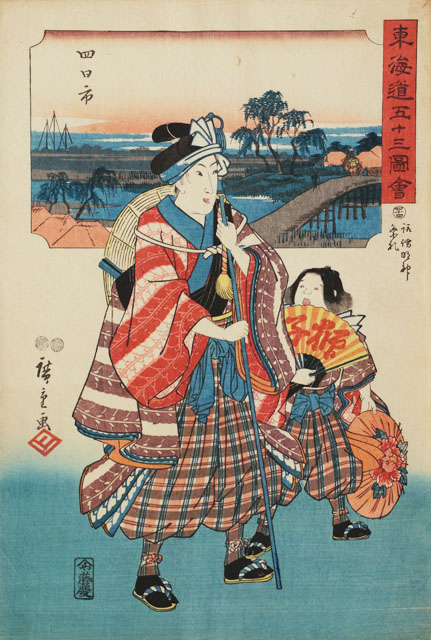
歌川広重「東海道五十三図会 四十四 諏訪明神祭礼」
江戸時代の遊郭である吉原では、八月になると俄という祭りが催され、メインストリートである仲之町の大通りでは男装した芸者たちによる獅子舞や俄狂言などが演じられました。芸者たちは鳶の扮装をしたり、助六などの有名なお芝居を演じて祭りを盛り上げたようです。山王祭や神田祭など、各地の祭礼でも附祭と呼ばれる同様の風俗が見られます。
物語にみる女装・男装
日本では、『古事記』に見られるヤマトタケルが女装して熊襲を退治した話や、牛若丸が五條橋で女装の稚児として弁慶と戦うという話など、異性装の話は古くから見られます。また江戸時代には、歌舞伎に登場する女装の盗賊、弁天小僧や、小説『南総里見八犬伝』に登場する女装の剣士・犬坂毛野などが人気を呼びました。ここでは、物語に登場する異性装の人物たちを紹介します。
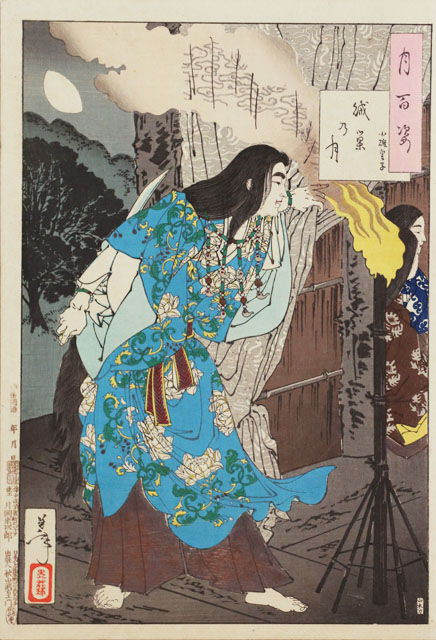
月岡芳年「月百姿 賊巣の月 小碓皇子」
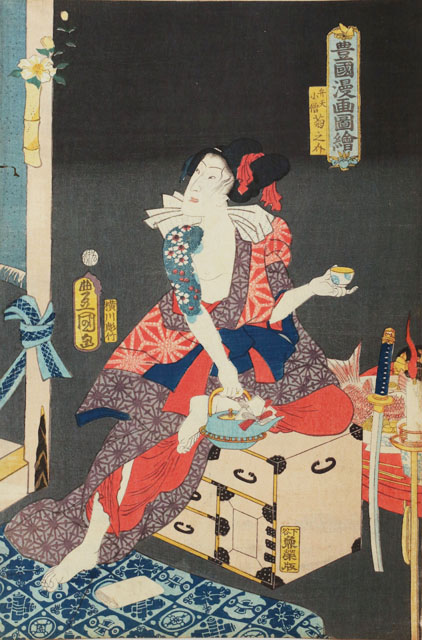
歌川国貞(三代豊国) 「豊国漫画図絵 弁天小僧菊之介」
女装のスペシャリスト―歌舞伎の女形
歌舞伎の始まりである出雲の阿国の一座では、阿国などの女性が男装をし、男性が女装をしていたとされます。寛永6年(1629)に女性が歌舞伎に出演することが禁じられて以降、女形(方)が女性を専門的に演じるようになり、女形の名優が数多く登場しました。女形は日常生活でも女性のように暮らすことを推奨されたと言い、いわば女装のスペシャリストとも言えるでしょう。
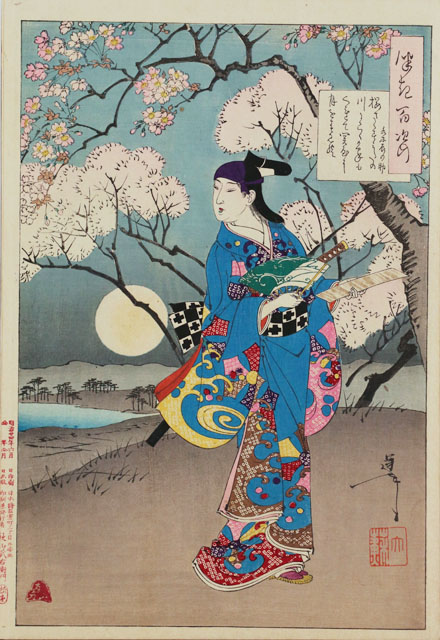
月岡芳年「つき百姿 桜さくすみだの川にこぐふねもくれて関屋に月をこそ見れ 水木辰の助」
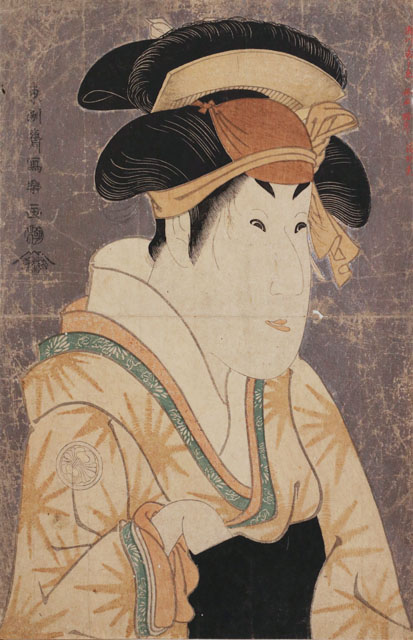
東洲斎写楽「三代目瀬川菊之丞の田辺文蔵女房おしづ」
歌舞伎や浮世絵にみる男女入替え
歌舞伎では「女助六」や「女清玄」のように、通常では立役(男性役)が演じる登場人物を、男女の設定を入替えて女形が演じる趣向があります。また浮世絵では、歴史や物語の登場人物などを、時に男女を入替えて当世風の人物に置き換える「やつし絵」や「見立絵」なども盛んに描かれました。ここでは江戸の庶民たちが楽しんだ、洒落た男女入替えの趣向を紹介します。
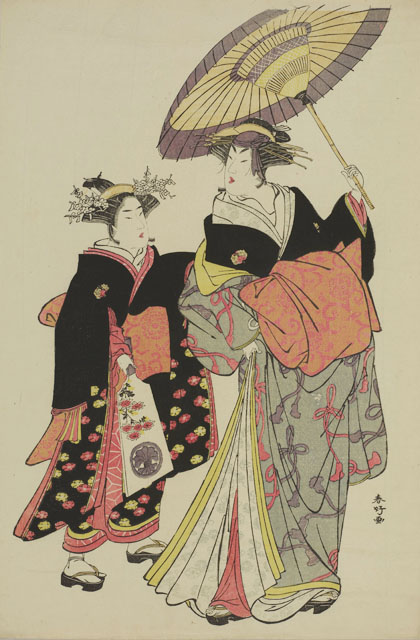
勝川春好「三代目瀬川菊之丞の女助六」
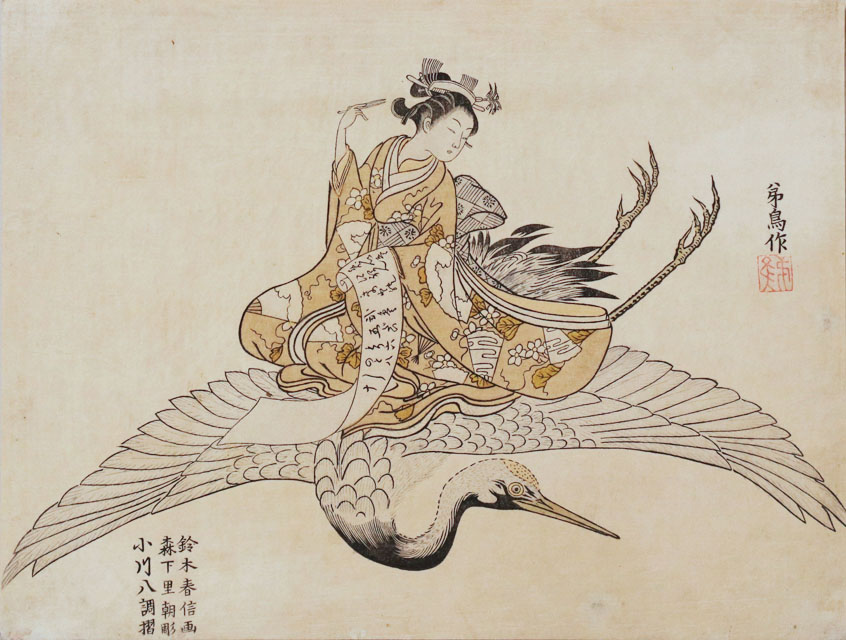
鈴木春信「やつし費長房」
見どころの作品
月岡芳年「風俗三十二相 にあいさう 弘化年間廓の芸者風俗」
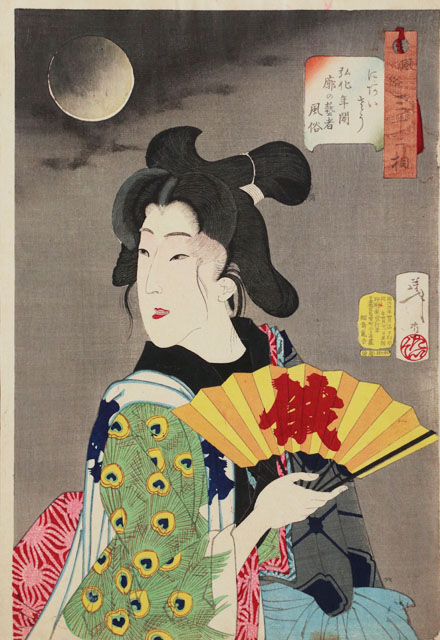
「風俗三十二相」は、月岡芳年が晩年に手掛けた、32枚からなる美人画の揃物です。寒そう、痛そうなどといった、さまざまな年齢や職業の女性たちの心情を題材にした内容で、本図には「にあいさう」とあります。何が「似合いそう」なのでしょうか。 本図に描かれているのは、画中の説明によると弘化年間(1844~48)の廓の芸者。廓、つまり吉原で八月に行われた祭りである「俄(にわか)」に参加した女芸者が、手古舞と呼ばれる鳶のような扮装をしています。女性は男髷を結った男装で描かれており、手には「俄」と書かれた扇を持っています。描かれた女芸者の男装姿がとても凛々しく、様になっていることから、「似合いそう」とあるのでしょう。
イベント
学芸員によるスライドトーク
展覧会の見どころを担当学芸員が解説します。
| 日程 | 2018年3月6(火)、15日(木)、21日(水・祝) |
|---|---|
| 時間 | 14:00~(40分程度) |
| 場所 | 太田記念美術館 視聴覚室(B1) |
| 参加方法 | 申込不要 参加無料(要入場券) |
入館料
| 一般 | 700円 |
|---|---|
| 大高生 | 500円 |
| 中学生以下 | 無料 |
Ukiyo-e from the end of the Edo Period to the Meiji Period
[2nd Term] February 2nd-25th
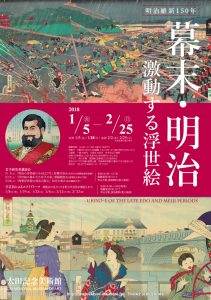
150 years ago, Japan experienced historical changes, from the downfall of the Edo shogunate to the establishment of the Meiji Government. Ukiyo-e artists who were active from the end of the Edo Period to the early Meiji Period portrayed social changes such as the Boshin War and westernization, and explored new forms of art by accepting Western styles. 2018 is the 150th year from the Meiji Restoration. In its commemoration, we introduce 150 pieces of ukiyo-e produced from the end of the Edo Period to the Meiji Period (the exhibits will be changed between the first term and the second term). Please enjoy the rapidly changing ukiyo-e, mirroring the turbulence from the end of the Edo Period into the Meiji Period.

Utagawa Yoshitora “Caricature of the Ueno War : Fire Attack of the Enryaku-ji Temple” (1st term)
Highlight ① 2018 is the 150th year from the Meiji Restoration. Let’s reflect upon this turbulent period.
The Boshin War started in 1868, ending in the collapse of the Edo shogunate. Edo changed its name to Tokyo, and modernized rapidly. Through the caricatures depicting the turmoil of the end of the Edo period and pictures portraying the modernized landscapes of Tokyo, we will reflect upon this dynamic period.

Utagawa Hiroshige Ⅲ ”Scenery of Brick Masonry Building at Kyōbashi in Tokyo” (2nd term)
Highlight ② Saigō Takamori as depicted by ukiyo-e artists
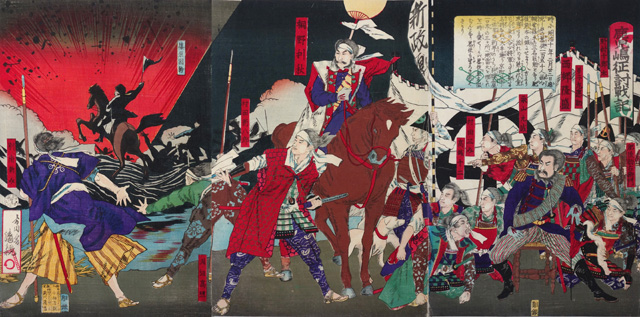
Kobayashi Kiyochika “Troop of Saigō Takamori Attacking Kumamoto Castle”(1st term)
Highlight③ Tsukioka Yoshitoshi and Kobayashi Kiyochika. Ukiyo-e artists who gathered attention in this period.
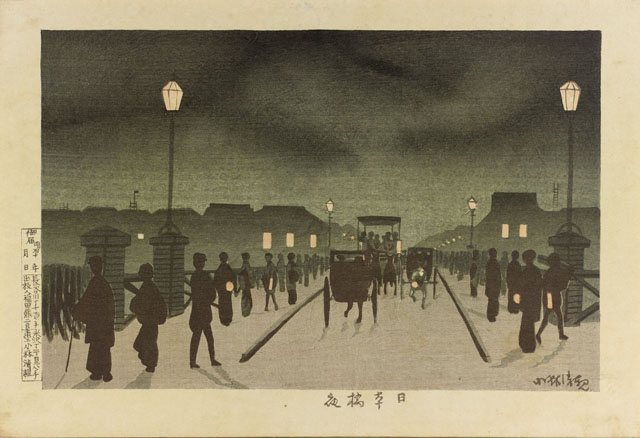
Kobayashi Kiyochika “Night Sight at Nihonbashi”(2nd term)
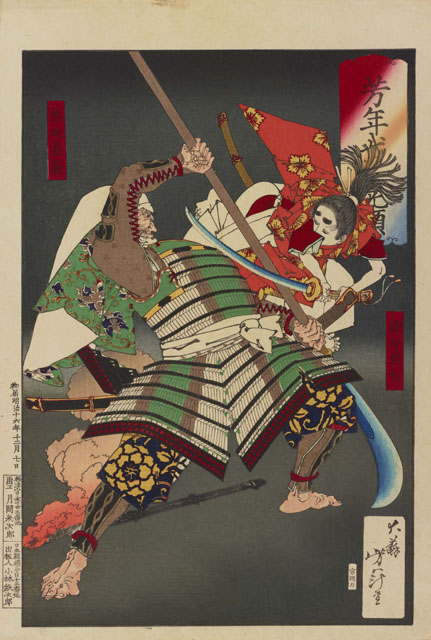
Tsukioka Yoshitoshi “Yoshitoshi’s Courageous Warriors : Minamoto-no Ushiwakamaru Battling with Kumasaka Chōhan”
(1st term)
<Highlight work of Exhibition>
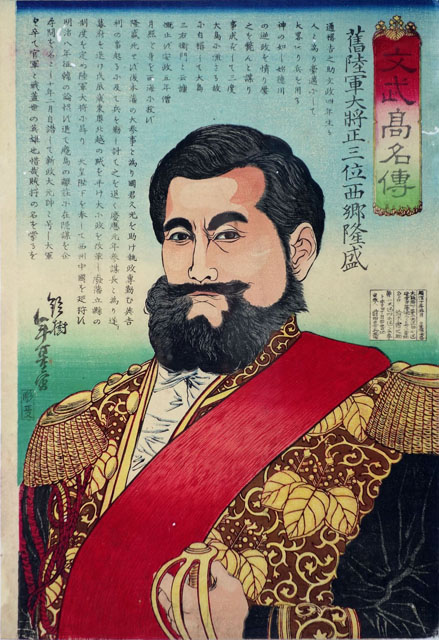
Suzuki Toshimoto “Famous People for Both Literary and Military Arts : Saigō Takamori” (1st term)
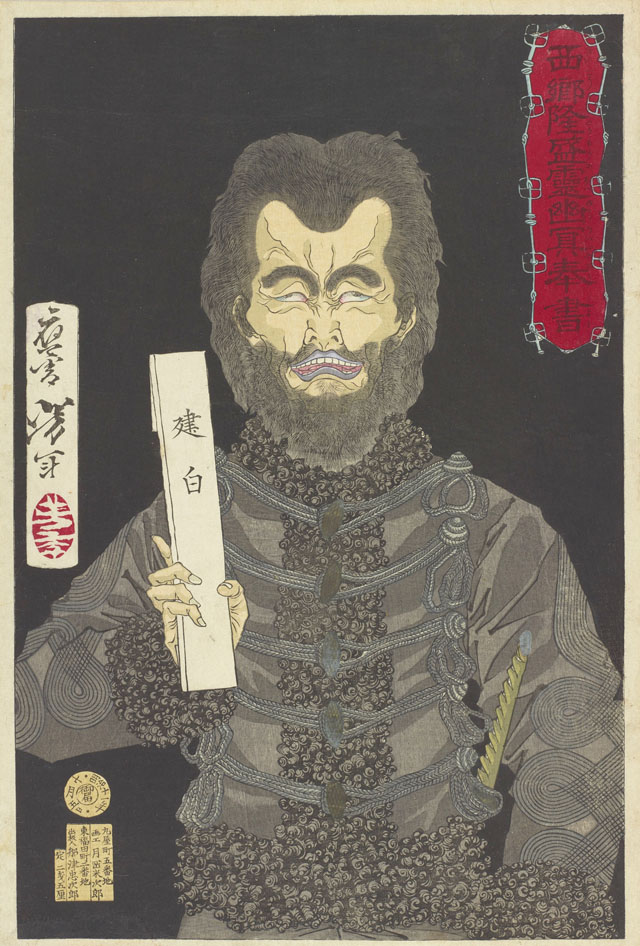
Tsukioka Yoshitoshi “Ghost of Saigō Takamori Holding a Petition” (2nd term)
Admission
| Adult | 700 yen |
|---|---|
| University and High school students | 500 yen |
| Junior High School Students and below | Free |
Calendar
Closed
-
-
2018 January
SUN MON TUE WED THU FRI SAT 1 2 3 4 5 6 7 8 9 10 11 12 13 14 15 16 17 18 19 20 21 22 23 24 25 26 27 28 29 30 31
-
-
2018 February
SUN MON TUE WED THU FRI SAT 1 2 3 4 5 6 7 8 9 10 11 12 13 14 15 16 17 18 19 20 21 22 23 24 25 26 27 28
明治維新150年 幕末・明治 ―激動する浮世絵
後期 2月2日(金)~25日(日)

今から約150年前、長らく続いた江戸幕府が崩壊し、新たに明治政府が樹立するという、時代の大きなうねりが起こりました。幕末・明治の浮世絵師たちは、時には、戊辰戦争や文明開化といった社会の変化を描き、時には、西洋文明の影響を受け入れながら、新たな絵画表現にチャレンジしました。
来年、平成30年(2018)は、明治維新からちょうど150年にあたります。それを記念し、本展覧会では、幕末から明治にかけて制作された浮世絵約150点(前後期で展示替えあり)を紹介します。幕末・明治という時代にあわせて激動していく浮世絵をお楽しみください。

歌川芳虎「信長公延暦寺焼討ノ図」(前期展示)
展示の見所① 2018年は明治維新から150年。激動の時代を見つめ直す
慶応4年(1868)、戊辰戦争が勃発し、江戸幕府が瓦解。江戸の町は東京と名前を変え、急速な近代化が進みました。幕末の動乱を伝える風刺画や、近代化した東京の街並みを描いた開化絵をとおして、激動の時代を見つめ直します。

三代歌川広重「東京名所京橋従煉化石之真図」(後期展示)
展示の見所② 浮世絵師たちが描いた西郷隆盛

小林清親「鹿児嶋征討戦記」(前期展示)
展示の見所③ 月岡芳年、小林清親。注目される幕末・明治の浮世絵師たちを紹介

小林清親「日本橋夜」(後期展示)

月岡芳年「芳年武者旡類 源牛若丸 熊坂長範」(前期展示)
見どころの作品
鈴木年基「文武高名伝 旧陸軍大将正三位西郷隆盛」
月岡芳年「西郷隆盛霊幽冥奉書」

鈴木年基「文武高名伝 旧陸軍大将正三位西郷隆盛」個人蔵(前期展示)

月岡芳年「西郷隆盛霊幽冥奉書」(後期展示)
一方、芳年の描いた西郷は、眼の焦点が定まらず、唇も紫色になっています。制作は明治11年(1878)7月。すでに西南戦争に敗れて自刃した後で、幽霊となって建白書を届けようとしている姿として描かれています。西郷の不気味な姿は、国の将来に対する不安を象徴しているかのようです。
イベント
学芸員によるスライドトーク
展覧会の見どころを担当学芸員が解説します。
| 日程 | 2018年1月8(月・祝)、19日(金)、23日(火)、 2018年2月6日(火)、12日(月・祝)、23日(金) |
|---|---|
| 時間 | 14:00~(40分程度) |
| 場所 | 太田記念美術館 視聴覚室(B1) |
| 参加方法 | 申込不要 参加無料(要入場券) |
若手研究者講演会
| 日程 |
2018年2月3日(土)「明治の浮世絵にみる《江戸》-楊洲周延を中心に」村瀬可奈氏(町田市立国際版画美術館) 2018年2月17日(土)「浮世絵に描かれた母子の姿 -喜多川歌麿と菊川英山を中心に」洲脇朝佳氏(國學院大學大学院) 2018年2月24日(土)「肉筆浮世絵の技法と復元」向井大祐氏(東京藝術大学) |
|---|---|
| 時間 | 14:00~15:30 |
| 場所 | 太田記念美術館 視聴覚室(B1) |
| 参加方法 | 申込不要 参加無料(要入場券) |
入館料
| 一般 | 700円 |
|---|---|
| 大高生 | 500円 |
| 中学生以下 | 無料 |
Kikukawa Eizan
[2nd Term] December 1st-20th
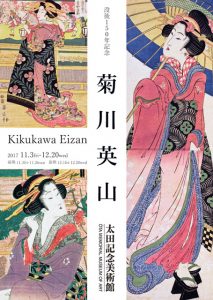

Woman with an Umbrella [1st Term]
Kikukawa Eizan (1787-1867) was an ukiyo-e artist playing an active part especially in the Bunka era (1804-1818) after the death of Kitagawa Utamaro. While many ukiyo-e artists portrayed beautiful women in the sophisticated and ethereal Utamaro style, Eizan ushered in a new phase in the bijinga genre; although his women too wear the latest fashionable kimonos, he established his own sweet down-to-earth vision of female beauty. His works portrayed a diverse range of women from different social classes, such as the graceful young ladies of samurai families, charming daughters of merchants, or flamboyant courtesans. We see them sleek, svelte, and elegant, or sometimes bright, colorful, and fashionable. In recent years, Eizan’s bijinga are not well-known, but these works would have profoundly influenced not only his pupil Keisai Eisen, but also such later artists as Utagawa Kunisada and Utagawa Kuniyoshi. It is no exaggeration to say that bijinga in the 19th century started from Eizan.
This year commemorates the 150th year since the death of Kikukawa Eizan. This exhibition is made up of some 200 outstanding works, covering wood-block prints and nikuhitsu-ga (original paintings), including important representative pieces and works shown to the public for the first time; together they once again shine the spotlight on Kikukawa Eizan’s achievements as an ukiyo-e artist. We would be grateful if, through this exhibition, you can fully enjoy the fascination of Eizan’s beauties that blossomed so gracefully in response to the culture of the late Edo period.
Finally, we would like to sincerely express our gratitude to all those collectors who loaned their valuable works and materials to the exhibition, and all those involved in the mammoth task of assembling this wonderful display of the artist’s works.
The blossoming of Eizan’s beauties
It was in his late teens that Kikukawa Eizan made his debut into the world of ukiyo-e with his animated bijinga (ukiyo-e prints of beautiful women). Working first in the style of Kitagawa Utamaro he became a popular ukiyo-e artist at a young age, and after Utamaro’s death, Eizan, in his mid-twenties, began exploring a new style of bijinga, finally reaching an image of charming, slender, and elegantly-proportioned women with beguiling large dark eyes. Utamaro’s beauties are tall and slim and living in a world free of cares; they are the super models of their times. While the sweet charming and smaller beauties of Eizan are approachable with an everyday feel about them akin to the photos of reader models appearing in today’s fashion magazines. Eizan’s women and their new fresh beauty were much loved by people in the city of Edo.

Comparison of the Flowery Courtesans of Yoshiwara : Chōzan and Nishikido of the Chōji-ya House[1st Term]
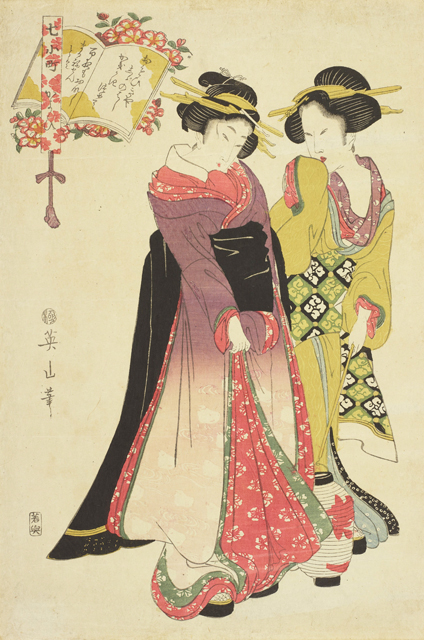
Seven Beauties Based on the Stories of Ono-no Komachi : Geisha Going to a Banquet [2nd Term]

Six Views of theTama River and Beauties in Pleasure Quarters : Yamashiro Province, Courtesan Hashitate of the Ōgi-ya House [2nd Term]
Eizan’s beauties were models of women’s fashion
In Eizan’s works, women who lent color and charm to the streets of Edo constantly appear: pretty girls attracting customers to the many teahouses, mothers and daughters strolling, geishas or courtesans entertaining. All of his works give us an exciting glimpse into this attractive world of high fashion, stylish kimono, and beautiful accessories. And yet, in those days, according to a woman’s social class or age there were restrictions and rules concerning hairstyles, makeup, and even prescribing the manner of wearing kimono; against such a backdrop how to enjoy and exploit the latest fashion was a great concern for women in Edo. Eizan’s beauties proclaimed the latest trends of this fashion-conscious society and were a visual guide of the rules applied to such themes as the seasonal motifs spread by popular actors, or sasairo-beni (iridescent lip rouge), which would have excited the hearts of women in just the same way as our present-day glossy fashion magazines.

Morning Glories and Three Beauties [2nd Term]

Lantern Festival at Yoshiwara in Autumn [2nd Term]
Shining the spotlight on a neglected period in bijinga
In any discussion of ukiyo-e bijinga, the Bunka era (1804-1818), when Eizan was at his most energetic, does not normally draw much attention. In recent years, however, exhibitions of Keisai Eisen, his pupil, and Utagawa Kuniyoshi, and Utagawa Kunisada have been held, and those ukiyo-e artists who flourished around the end of the Edo period, are now gaining in popularity. This exhibition, displaying Eizan’s works in chronological order, reconsiders the significance of his bijinga, and how they connected the grand master Kitagawa Utamaro to those artists in the closing days of the Tokugawa Shogunate.
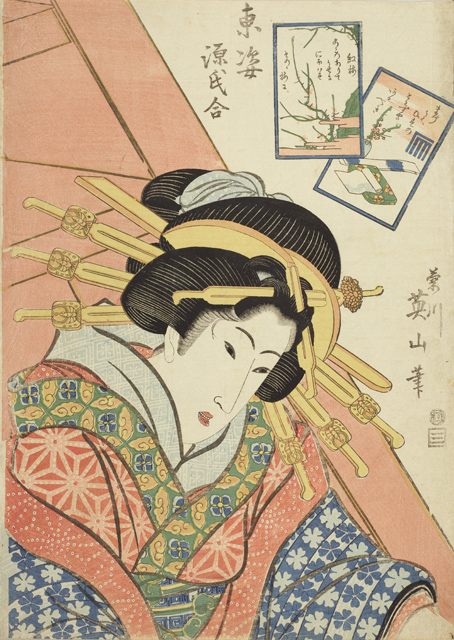
Women of Edo with the Cards of the Tale of Genji : Red Plum Blossom [1st Term]
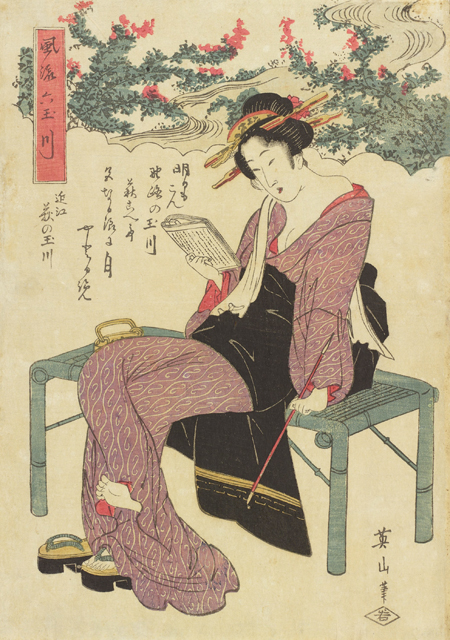
Six Views of theTama River : Ōmi Province, Bush Clovers around the Tama River [1st Term]
An array of the finest works, including some on public display for the first time, and others from the outstanding Japan Ukiyo-e Museum Collection
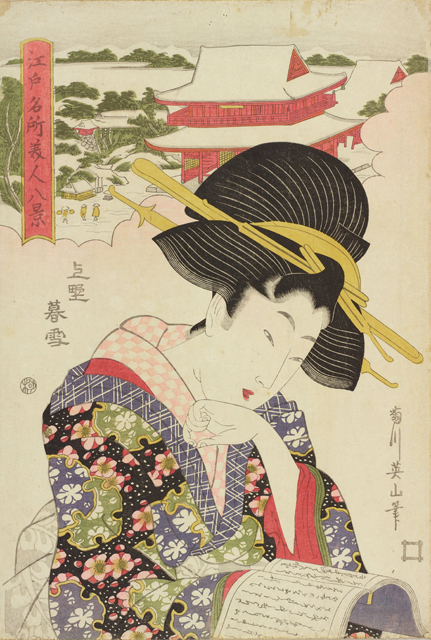
Eight Famous Places and Beauties of Edo : Evening Snow at Ueno [1st Term]

Six Views of theTama River : Ōmi Province, Bush Clovers around the Tama River [1st Term]
<Highlight work of Exhibition>
Six Views of theTama River [1st Term]
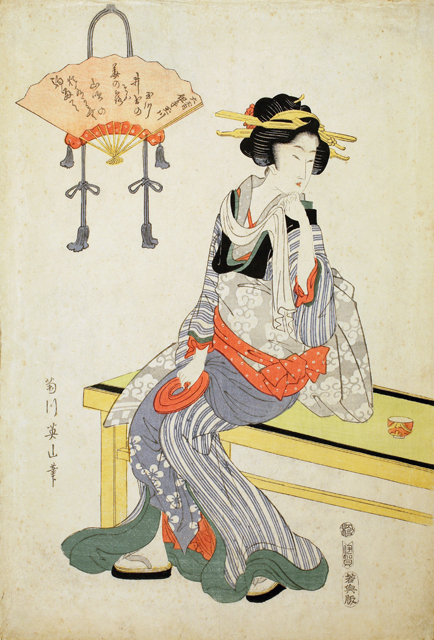
This well-preserved picture from the Japan Ukiyo-e Museum Collection is a superb work and the pale blue color, which usually would have faded over time, is still clearly distinct. A woman sitting on a bench in a tea stall is lost in thought; in those days tea stalls were commonly set up in any busy place, such as a temple or shrine, and good-looking women often worked in such places. At first sight the woman appears modestly dressed in a bluish purple striped kimono, with a floral pattern apron and a grey cloud pattern obi sash, but her apron strap and other items colored in vermillion provide very effective high-lights; her fingertips holding a hand towel draped from her shoulder are depicted very softly, suggesting a gentle and alluring feminine presence. This print crystalizes an idealized image of woman.
Translation Supervised by Japanese Students Association of Princeton University
Admission
| Adult | 1000 yen |
|---|---|
| University and High school students | 700 yen |
| Junior High School Students and below | Free |
開館日カレンダー
休館日
-
2017 NovemberSpecial Exhibition
SUN MON TUE WED THU FRI SAT 1 2 3 4 5 6 7 8 9 10 11 12 13 14 15 16 17 18 19 20 21 22 23 24 25 26 27 28 29 30 -
2017 DecemberSpecial Exhibition
SUN MON TUE WED THU FRI SAT 1 2 3 4 5 6 7 8 9 10 11 12 13 14 15 16 17 18 19 20 21 22 23 24 25 26 27 28 29 30 31
Katsushika Hokusai “Thirty-six Views of Mt. Fuji”
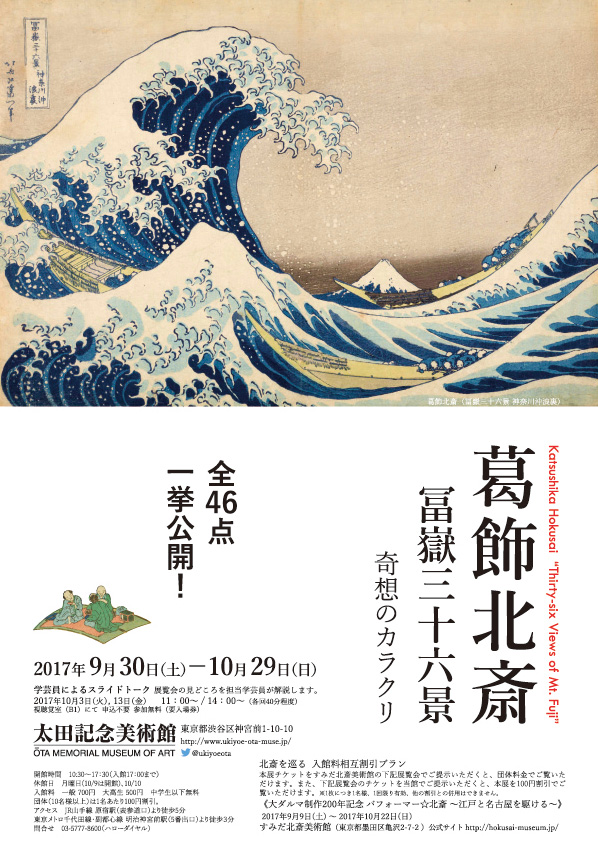
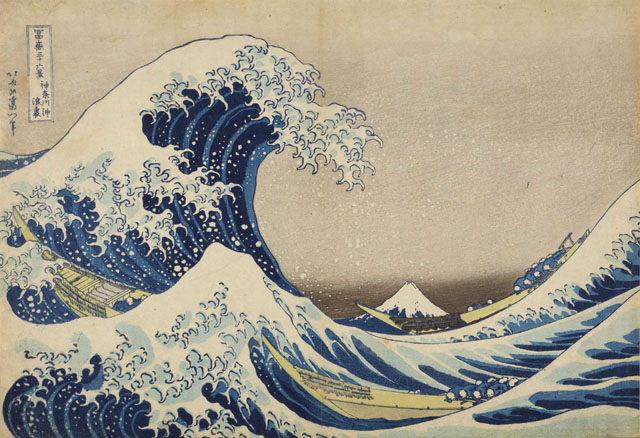
Katsushika Hokusai “Thirty-six Views of Mt. Fuji: Great Wave off the Coast of Kanagawa”
Exhibition of the complete 46 works of Hokusai‘s “Thirty-six Views of Mt. Fuji”
“Thirty-six Views of Mt. Fuji” is a series of landscape prints, depicting Mt. Fuji from various locations in Japan. Despite the number “36” in the title, the series actually consists of “46” works, since 10 more works were added later due to the successful sales and popular demand. The complete 46 works, owned by Ōta Memorial Museum of Art, will be exhibited for the first time in the 7 years since 2010. We hope you will enjoy the greatest masterpieces by Hokusai.

Katsushika Hokusai “Thirty-six Views of Mt. Fuji: Mild Breeze on a Fine Day”
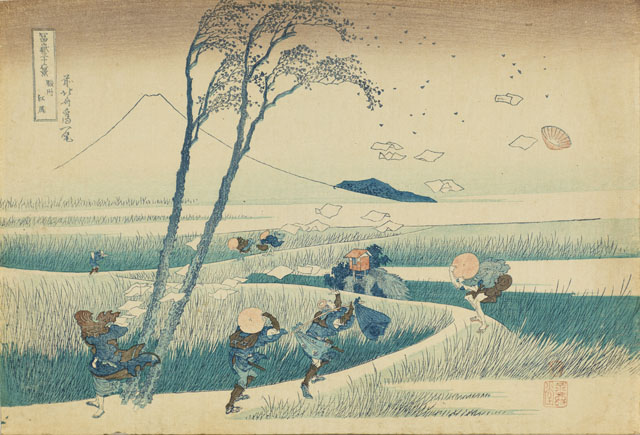
Katsushika Hokusai “Thirty-six Views of Mt. Fuji: Ejiri in Suruga Province”
Deciphering the innovative ideas hidden in “Thirty-six Views of Mt. Fuji“
The series is full of unconventional, original and striking ideas, as seen in “Mild Breeze on a Fine Day” and “Great Wave off the Coast of Kanagawa” as fine examples. It is perhaps Hokusai‘s new enlightenment that he had achieved when he passed 70, after his persistent devotion to ukiyo-e as an artist. In this exhibition, we will try to decipher Hokusai‘s innovative ideas hidden in “Thirty-six Views of Mt. Fuji“.
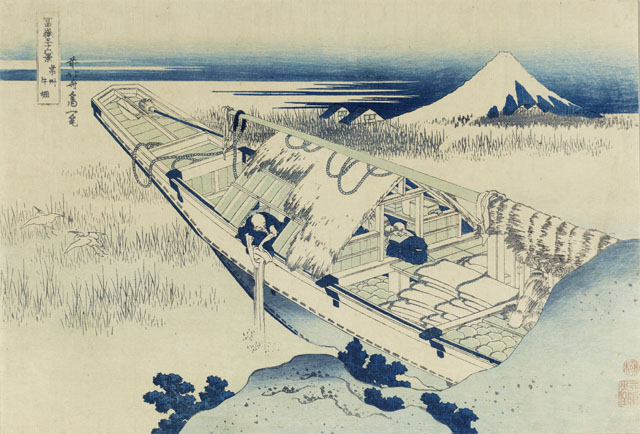
Katsushika Hokusai “Thirty-six Views of Mt. Fuji: Ushibori in Hitachi Province”

Katsushika Hokusai “Thirty-six Views of Mt. Fuji: View from Sazai-dō Hall of the Gohyaku Rakan-ji Temple”

Katsushika Hokusai “Thirty-six Views of Mount Fuji: In the Mountains of Tōtoumi Province”

Katsushika Hokusai “Thirty-six Views of Mt. Fuji: Under Mannen-bashi Bridge at Fukagawa”
Special exhibition of “Courtesans Showing Themselves to the Strollers through the Grille ” by Hokusai‘s daughter Ōi
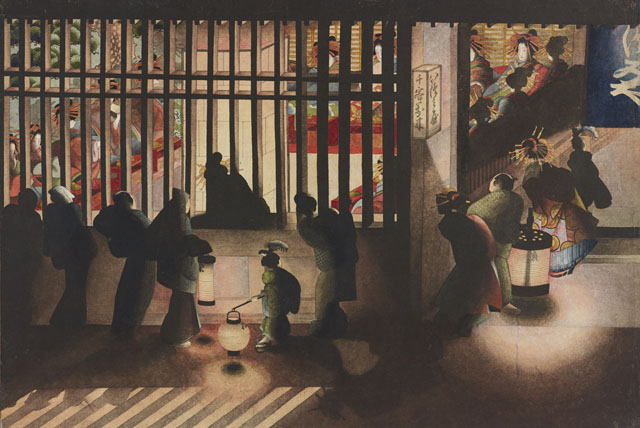
Katsushika Ōi “Courtesans Showing Themselves to the Strollers through the Grille”
*A TV drama based on the historical novel by Makate Asai,, a winner of the Naoki Prize (a literary award), will be broadcast on NHK on 18th September, starring Aoi Miyazaki, with a screenplay by Mika Ōmori.
<Highlight work of Exhibition>
Katsushika Hokusai “Thirty-six Views of Mt. Fuji:: Shower below the Summit”
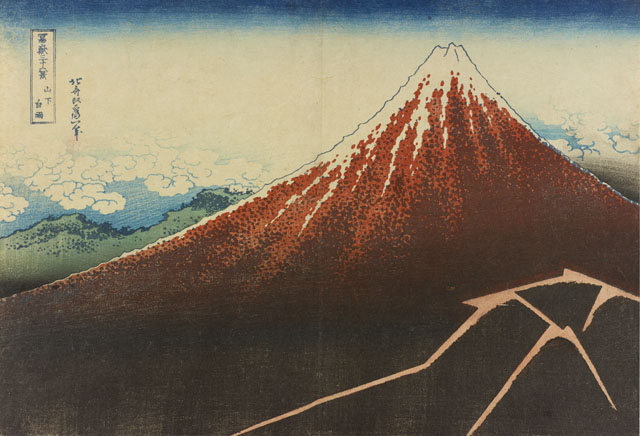
Although the sky above Mt. Fuji is clear and blue, the bottom of the mountain is covered with black, dark cloud. The diagonal lines depicted at the bottom right corner represent the stylized lightening. The picture is a simply expressed depiction of the mountain’s foot being hit by a sudden, heavy thunder storm. It is an outstanding work of Hokusai, with his innovative idea: the two totally different weather events – fine weather and rain – are effortlessly represented in one painting.
Admission
| Adult | 700 yen |
|---|---|
| University and High school students | 500 yen |
| Junior High School Students and below | Free |
Calendar
Closed
-
2017年10月
SUN MON TUE WED THU FRI SAT 1 2 3 4 5 6 7 8 9 10 11 12 13 14 15 16 17 18 19 20 21 22 23 24 25 26 27 28 29 30 31
没後150年記念 菊川英山
後期 12月1日(金)~20日(水)


「傘をさす娘」太田記念美術館蔵(前期)
知られざる美人画の名手
菊川英山(1787~1867)という浮世絵師の名を知っている人はどれほどいるでしょうか。巨匠、喜多川歌麿の亡き後、多くの絵師が歌麿風の作品を手がけるなか、可憐でたおやかな女性像を確立して新時代の美人画をリードしたのが菊川英山でした。その作品には上品な武家の姫君から、愛らしい町娘、ゴージャスな遊女まで、さまざまな女性たちが時に優雅に、時にポップにカラフルに描かれます。こうした英山の美人画は弟子の溪斎英泉のみならず、近年人気の歌川国貞や歌川国芳など、以後の絵師たちに大きな影響を与えました。幕末の美人画は、英山から始まったと言っても過言ではないでしょう。
今年、菊川英山の没後150年を迎えることを記念し、本展覧会では、初公開作品や代表作を含む版画・肉筆画の優品約200点を通して、菊川英山の画業に再び光をあてます。東京で開催される回顧展としては32年ぶりです。新しい時代のなかでしなやかに花開いた英山美人の輝きをご堪能ください。
江戸の新しい女性像
菊川英山が浮世絵界にデビューしたのは10代後半の頃。喜多川歌麿風のはつらつとした美人画を描き若くして人気絵師となります。歌麿没後、20代半ばとなった英山は新しい美人画を模索し始めます。そして行き着いたのが黒目がちの瞳に、六頭身でほっそりとした体つきの愛らしい女性像でした。浮世離れしたスラリとした長身の歌麿美人がスーパーモデルなら、可憐で小柄な英山美人は読者モデルのような親しみやすさも備えています。こうした新しい女性美が江戸市民に広く愛されたのです。

「青楼名君花合 丁子屋内丁山 錦戸」太田記念美術館蔵(前期)
歌麿風の初期作品

「七小町 かよひ」太田記念美術館蔵(後期)
華奢な英山らしい女性像

「青楼六玉川のうち 山しろ 扇屋内 梯立」個人蔵(後期)
オシャレの手本は英山美人
茶屋の看板娘や母子、芸者や遊女など江戸の町を彩った女性たちが登場する英山作品。その魅力のひとつは女性たちがとてもオシャレだということ。当時、髪型や化粧、着こなしにいたるまで身分や年齢による制約があり、そのなかでいかに最新ファッションを楽しむかは、江戸女性の大きな関心事でした。人気役者が発信源の旬のモチーフやブームとなった笹色紅など、ルールのなかで最先端の流行を取り入れた英山美人は、現代のファッション雑誌さながらに女性たちの心を躍らせたことでしょう。

「朝顔の三美人」太田記念美術館蔵(後期)
大判錦絵三枚続の美人画。大判1枚ごとに女性1人を描く構図は英山が確立させ、以後主流となる。

「青楼之秋灯楼図」太田記念美術館蔵(後期)
美人画空白の時代に光をあてる
浮世絵美人画を語る際、英山が活躍した文化年間(1804~18)という時代は、これまであまり注目されてきませんでした。しかし近年、門弟の溪斎英泉や歌川国芳、歌川国貞の展覧会が開催され、幕末に活躍した絵師たちの人気が高まりつつあります。本展では作品を時代順に展示することで、喜多川歌麿と幕末の絵師たちをつないだ英山の美人画の意義を見直します。

「東姿源氏合 紅梅」太田記念美術館蔵(後期)
緻密な細部描写、やや硬い表情は弟子の英泉と共通する。

「風流六玉川 近江 萩の玉川」個人蔵(前期)
美麗な日本浮世絵博物館コレクション、初公開作品ほか、名品の数々

「江戸名所美人八景 上野暮雪」個人蔵(前期)

「風流曲水ノ宴」日本浮世絵博物館蔵(後期)
<見どころの一点>
「六玉内 伊手玉川」日本浮世絵博物館蔵(前期)

日本浮世絵博物館が所蔵する本図は、保存状態が良く退色しやすい淡い青色がよく残った逸品です。床几に座り物思いにふける様子の水茶屋の女性。当時、寺社など多くの人でにぎわう場所に設けられた水茶屋では、見目麗しい女性たちが働くことが多くありました。青紫の縞柄の着物に花模様の前掛、グレーの雲文の帯という装いは一見ひかえめですが、前掛の紐などの朱色が差し色としてとても効いています。また、楚々とした美しさに加えて、柔らかな指先やはだけた胸元からは匂い立つような色香が漂います。本図は、理想とされた女性像をひとつに凝縮した一点といえるでしょう。
展覧会カタログ
本展カタログ「没後150年記念 菊川英山」を2,500円(税込)にて販売します。入館料
リピーター割引 本展の会期中2回目以降ご鑑賞の方は、半券のご提示にて200円割引いたします。
※チケット購入時に半券をご提示下さい。他の割引との併用はできません。
| 一般 | 1000円 |
|---|---|
| 大高生 ※学生証をご提示ください。 | 700円 |
| 中学生以下 ※中学生は学生証(生徒手帳)をご提示ください。 | 無料 |
開館日カレンダー
休館日
-
2017年11月特別展
SUN MON TUE WED THU FRI SAT 1 2 3 4 5 6 7 8 9 10 11 12 13 14 15 16 17 18 19 20 21 22 23 24 25 26 27 28 29 30 -
2017年12月特別展
SUN MON TUE WED THU FRI SAT 1 2 3 4 5 6 7 8 9 10 11 12 13 14 15 16 17 18 19 20 21 22 23 24 25 26 27 28 29 30 31
葛飾北斎 冨嶽三十六景 奇想のカラクリ


葛飾北斎「冨嶽三十六景 神奈川沖浪裏」
北斎の「冨嶽三十六景」全46点を一挙公開
「冨嶽三十六景」は、富士山を日本全国のさまざまな場所から描いたシリーズで、天保2年(1831)頃に制作されました。題名に「三十六」とありますが、売れ行きがあまりに好評だったため、10点が追加され、全部で46点となっています。太田記念美術館が所蔵する「冨嶽三十六景」全46点が一挙に公開されるのは2010年以来7年ぶり。北斎の最高傑作を、ぜひたっぷりお楽しみください。

葛飾北斎「冨嶽三十六景 凱風快晴」

葛飾北斎「冨嶽三十六景 駿州江尻」
「冨嶽三十六景」の奇抜なアイデアを読み解く
「凱風快晴」や「神奈川沖浪裏」を筆頭に、「冨嶽三十六景」にはアッと驚くようなアイデアがふんだんに盛り込まれています。浮世絵師として絶え間なく研鑽を続けた北斎が、70歳を過ぎてたどりついた境地と言えるでしょう。本展では、「冨嶽三十六景」に隠された北斎の奇抜なアイデアを読み解いていきます。

葛飾北斎「冨嶽三十六景 常州牛堀」

葛飾北斎「冨嶽三十六景 五百らかん寺さゞゐどう」

葛飾北斎「冨嶽三十六景 遠江山中」

葛飾北斎「冨嶽三十六景 深川万年橋下」
北斎の娘・応為の「吉原格子先之図」を特別公開

葛飾応為「吉原格子先之図」
※直木賞作家・朝井まかて氏の時代小説が、『眩(くらら)~北斎の娘~』として、NHK総合でドラマ化。主演は宮崎あおい、脚本は大森美香。9/18(月・祝)放送予定。
<見どころの一点>
葛飾北斎「冨嶽三十六景 山下白雨」

富士山の山頂は晴れ渡っていますが、裾野は真っ黒な雲に覆われています。右下の斜めに走る線は雷を図様化したもの。富士山の下は白雨、すなわち、激しい夕立が降っていることを簡潔に表現しています。晴れと雨というまったく異なる天候を、一枚の画面の中に無理なく収めた、北斎らしい奇抜なアイデアが光る作品です。
イベント
学芸員によるスライドトーク
展覧会の見どころを担当学芸員が解説します。
| 日程 | 2017年10月3(火)、13日(金) |
|---|---|
| 時間 | 11:00~ / 14:00~(各回40分程度) |
| 場所 | 太田記念美術館 視聴覚室(B1) |
| 参加方法 | 申込不要 参加無料(要入場券) |
北斎を巡る 入館料相互割引プラン
本展チケットをすみだ北斎美術館の下記展覧会でご提示いただくと、団体料金でご覧いただけます。また、上記展覧会のチケットを当館でご提示いただくと、「葛飾北斎 冨嶽三十六景 奇想のカラクリ」展を100円割引でご覧いただけます。
※1枚につき1名様、1回限り有効、他の割引との併用はできません。
すみだ北斎美術館
「大ダルマ制作200年記念 パフォーマー☆北斎~江戸と名古屋を駆ける~」
2017年9月9日(土) ~ 2017年10月22日(日)
入館料
| 一般 | 700円 |
|---|---|
| 大高生 | 500円 |
| 中学生以下 | 無料 |
Tsukioka Yoshitoshi “One Hundred Views of the Moon”
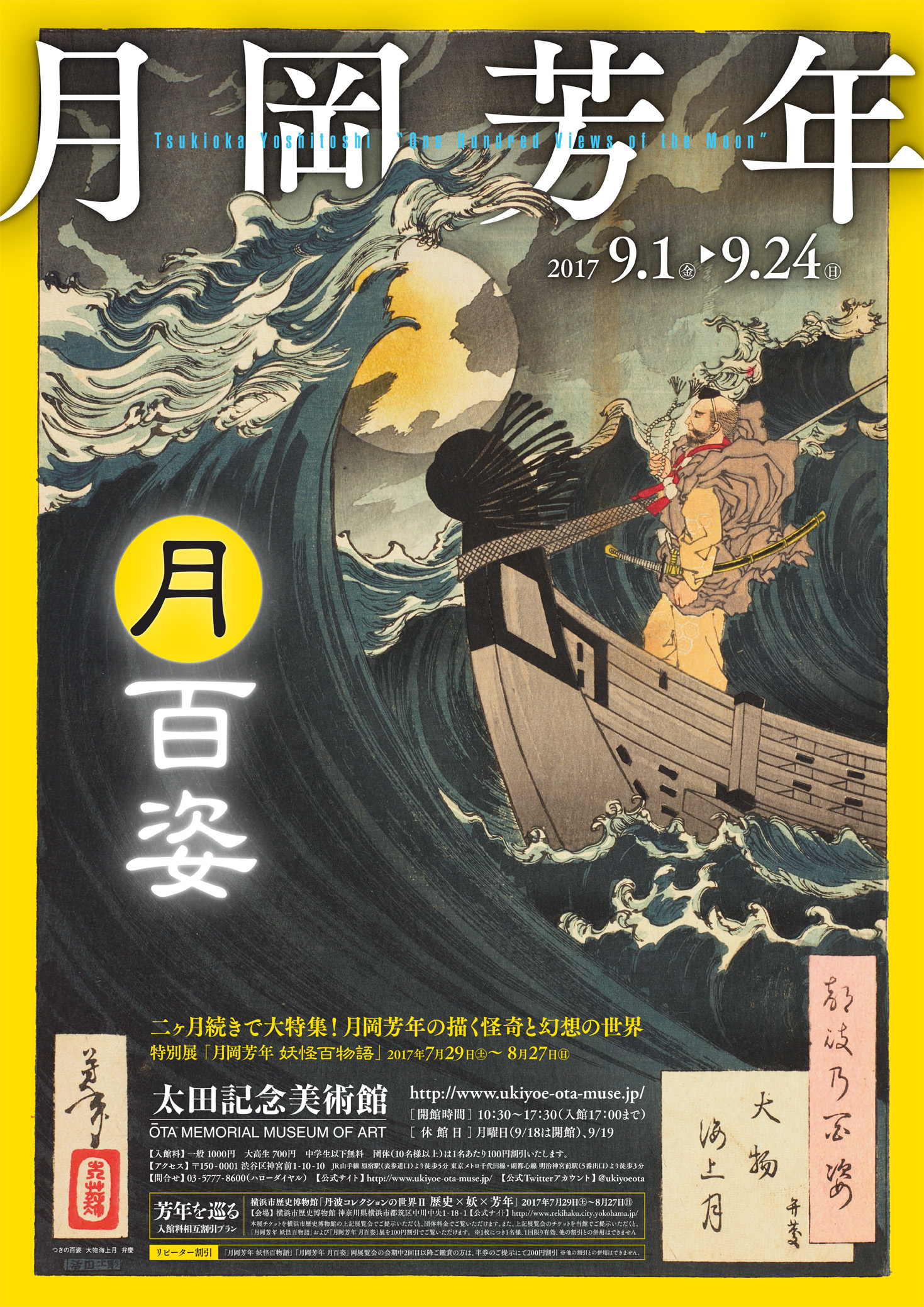
Exhibition of the complete 100 works of “One Hundred Views of the Moon”: Tsukioka Yoshitoshi’s most well-known works from his last year
Following our previous exhibition “Specters by Tsukioka Yoshitoshi” (July 29 ~ August 27, 2017), we would like to further explore in depth the fascinating world of Tsukioka Yoshitoshi, an ukiyo-e artist who lived from the end of the Edo period to the Meiji period. In this exhibition, we will present “One Hundred Views of the Moon” series, which are Yoshioshi’s masterpieces from his last year. As the title describes, “One Hundred Views of the Moon” consists of a total of 100 pictures. This exhibition provides a very rare opportunity to see all the pictures in one place. It is also an unmissable opportunity to see the ultimate achievement of Yoshitoshi, who is renowned as the last ukiyo-e master.

“Moon of Pure Snow at the Asano River : Chikako, the Filial Daughter
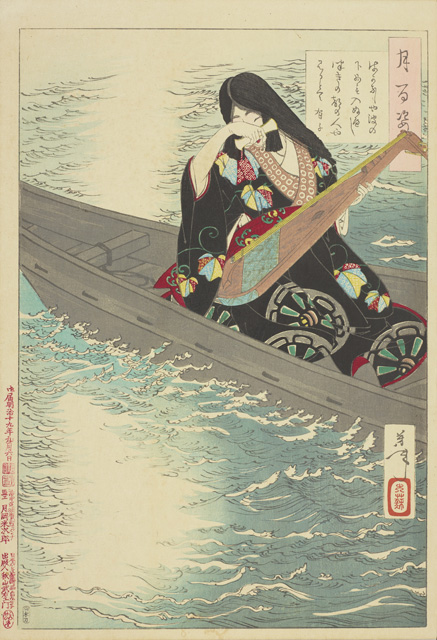
‘”How hopeless it is, it would be better for me to sink beneath the waves perhaps then I could see my man from moon capital” -Poem by Ariko
Appreciating “One Hundred Views of the Moon” from four different aspects
The themes of “One Hundred Views of the Moon” are based on stories related to the moon. They vary widely, from warriors and beautiful women in the Heian period and the Age of Civil Wars, to mystic creatures such as ghosts and monsters. In this exhibition, we will aim to present a clearer view of the world of “One Hundred Views of the Moon” by categorizing them based on four different aspects: 1) beautiful women; 2) specters, ghosts, deities and Buddha; 3) brave men; and 4) refinement, nostalgia and sorrow. We hope you will enjoy a variety of stories surrounding the moon, which are appropriate for the autumn, the season of beautiful moon.
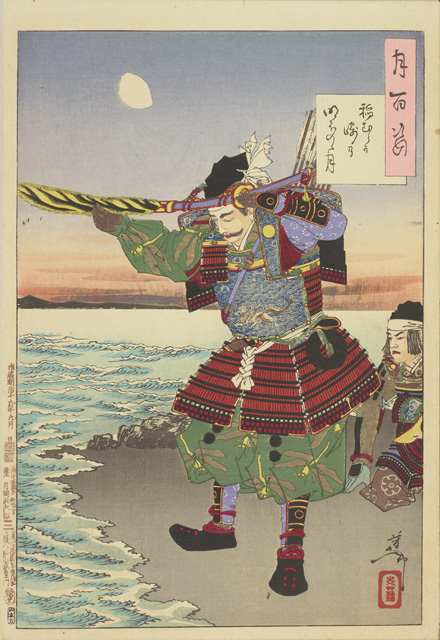
“Moon over Cape Inamura at Daybreak”
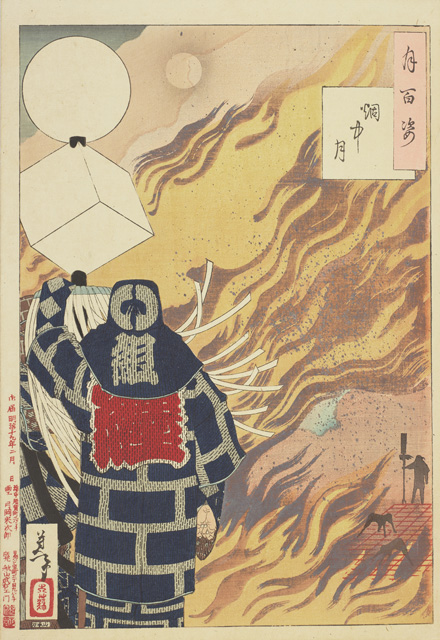
“Moon through Conflagration”
Innovative compositions and vivid colors are still fresh even after more than 100 years
Even though the “One Hundred Views of the Moon” series were created between 1885 and 1892, more than 130 years ago, they are still full of freshness and charm. The powerful compositions cropped out from a dynamic viewpoint, the sense of serenity that fills the air with silence on a moonlight night, and
the sophisticated carving skills and the beauty of prints presented in these works make the viewers say “Cool!” or “Beautiful!” even in modern days. The “newness” of “One Hundred Views of the Moon” is highlighted in this exhibition.
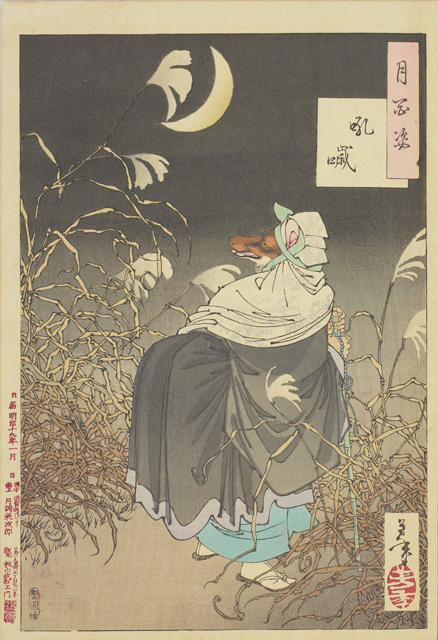
“Cry of the Fox”
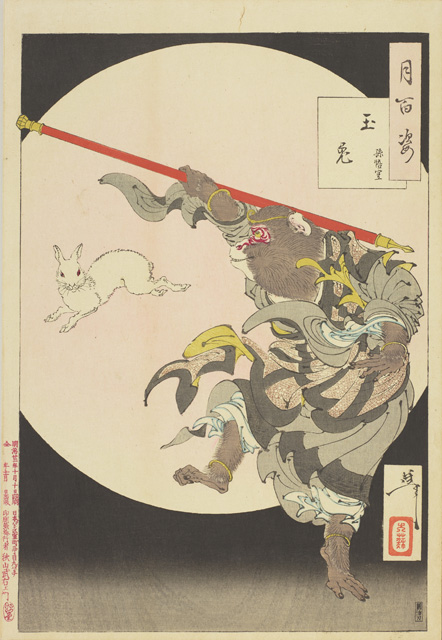
“Jade Rabbit and Sun Wukong”
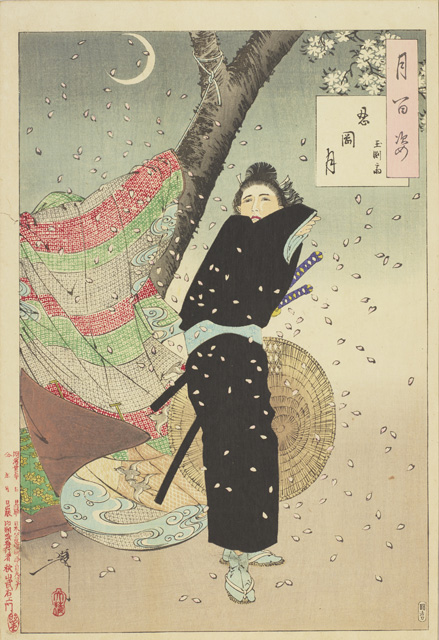
“Moon at Shinobugaoka : Gyokuensai”
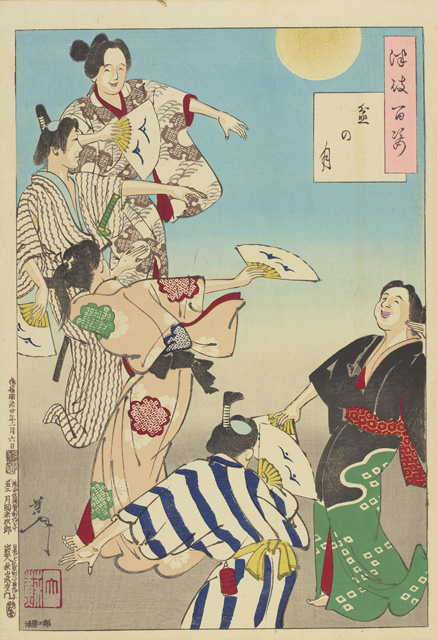
“Moon above the Bon Festival”
<Highlight work of Exhibition>
“Moon Above the Daimotsu Bay : Benkei”
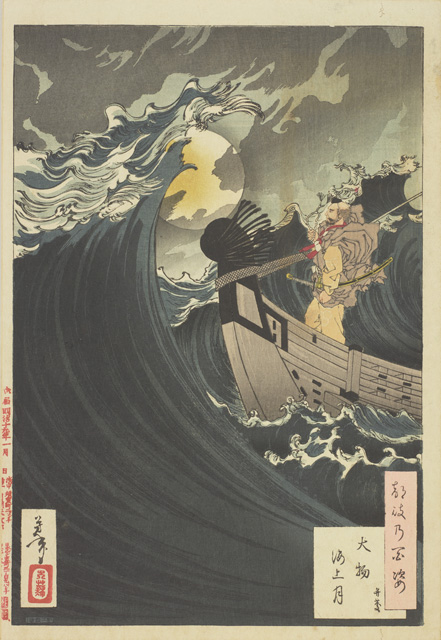
When Minamoto no Yoshitsune and his retainers embarked from Daimotsu Bay, suddenly a storm came and vengeful ghosts of Heike warriors, who were defeated and sank into Dan-no-ura Bay, tried to prevent Yoshitsune’s voyage. One of his retainers Benkei, however, impressively warded off the ghosts by chanting Buddhist prayers. Although the vengeful ghosts of Heike warriors are not clearly depicted in this work, the pitch-dark ocean that occupies a large part of the picture and the ominous movements of the waves that are crashing over Benkei give uneasy feelings to the viewers. This meticulously calculated, powerful picture represents typical characteristics of Yoshitoshi’s works.
Admission
| Adult | 1000 yen |
|---|---|
| University and High school students | 700 yen |
| Junior High School Students and below | Free |
Calendar
Closed
-
-
-
-
2017 SeptemberSpecial Exhibition
SUN MON TUE WED THU FRI SAT 1 2 3 4 5 6 7 8 9 10 11 12 13 14 15 16 17 18 19 20 21 22 23 24 25 26 27 28 29 30
-
-
-
Specters by Tsukioka Yoshitoshi
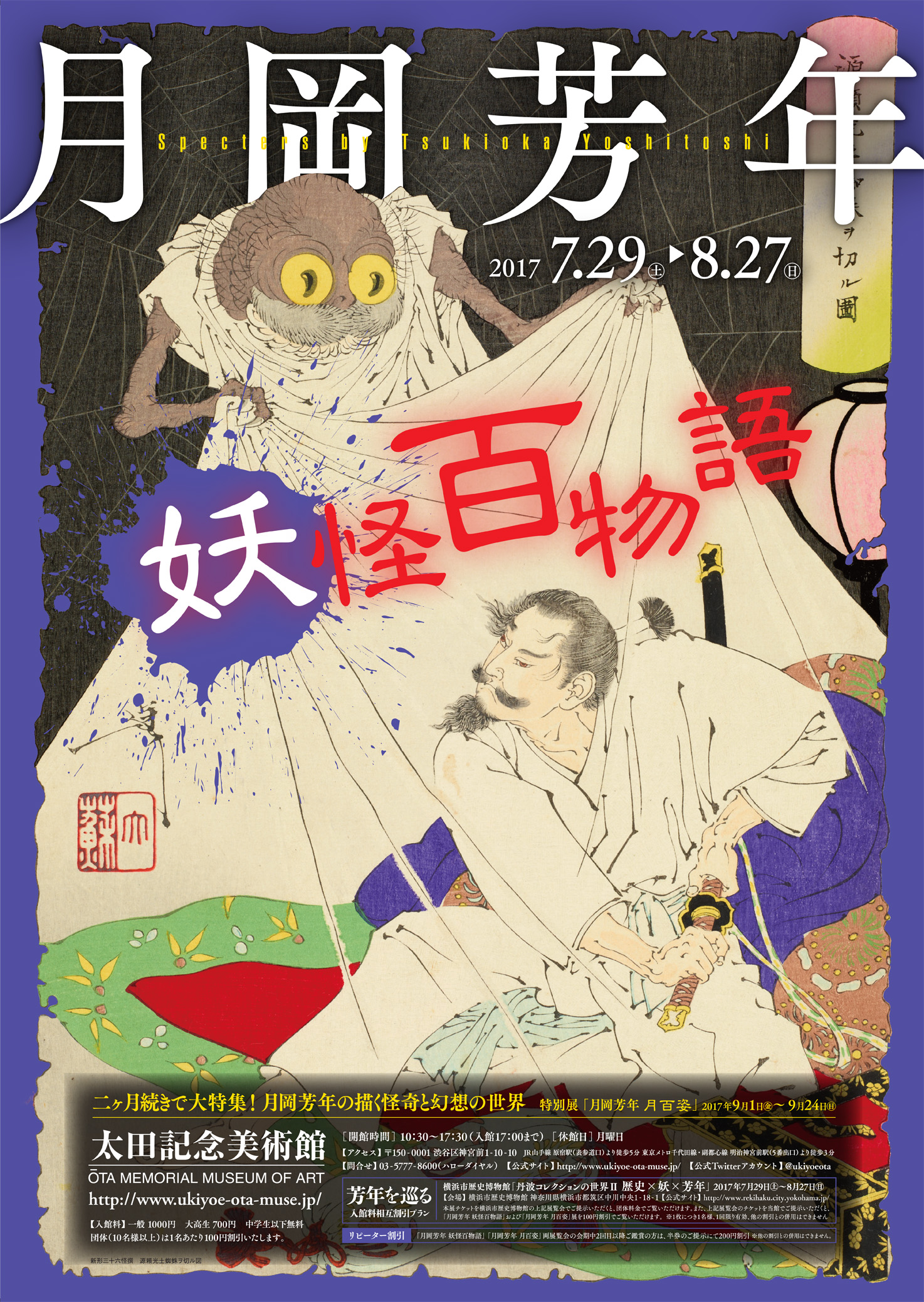
Introduction
Tsukioka Yoshitoshi (1839~1892) was an ukiyo-e artist who lived from the end of the Edo period to the Meiji period, and was a pupil of Utagawa Kuniyoshi. He was one of the leading and the most popular ukiyo-e artists in the Meiji period. Yoshitoshi produced a wide range of pictures, such as “warrior pictures”, “historical pictures” and “pictures of beautiful women”; however, what he focused on most throughout his life were “pictures of Yōkai (specters)” which took themes from mystic stories of history, legends, novels and plays. There is an anecdote that Yoshitoshi often saw ghosts, and he was also good at telling scary stories. It is said that he sometimes participated as a storyteller in “One Hundred Ghost Stories” gatherings (an event at which people gather to recount and listen to one hundred mysterious stories.) Among the large number of Yoshitoshi’s works, a set of pictures “One Hundred Ghost Stories of China and Japan”, which consists of 26 pictures produced in the early stage of his career as an artis, and a set of pictures “New Forms of Thirty-six Ghosts”, which consists of 36 pictures produced in his last years, are known as the masterpieces of “picture books of specters” in which a lot of specters and mysterious creatures appear. In this exhibition, we will exhibit the complete works of both “One Hundred Ghost Stories of China and Japan” and “New Forms of Thirty-six Ghosts”, as well as about 100 pictures from his early years to his later years, introducing Yoshitoshi’s world of “pictures of specters”.
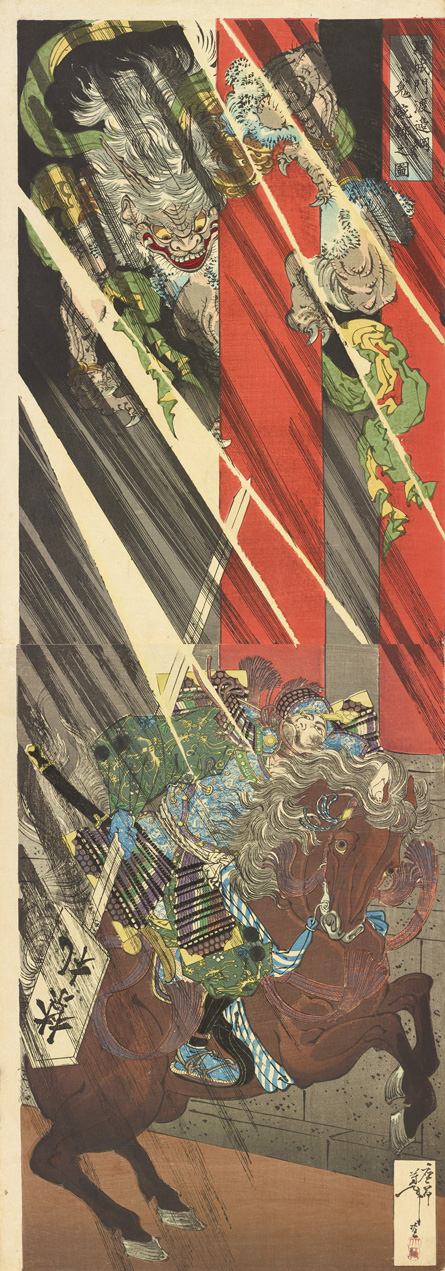
“Ogre at the Rashōmon Gate Attacking Watanabe-no Tsuna
Exhibiting about 100 “pictures of specters” by Tsukioka Yoshitoshi
Tsukioka Yoshitoshi showed his interest in mysterious subjects for his paintings from his early days as an artist, and continued drawing specters throughout his career. It is considered that Yoshitoshi was influenced by his master Utagawa Kuniyoshi, who excelled in painting specters. It is also said that Yoshitoshi himself had a feeling of closeness to mystic creatures, and the story of him often seeing ghosts has been passed down. There is an anecdote that he was good at telling scary stories and he used to read out “One Hundred Ghost Stories” to his adopted daughter. In this exhibition, we will introduce the fascinating specters drawn by Yoshitoshi, which are terrifying but sometimes humorous.

“Yoshitoshi’s Selection of One Hundred Warriors : Kingo Chūnagon Hideaki”

“Essays by Yoshitoshi : Takutō Tennō Chōgai”
The complete works of “One Hundred Ghost Stories of China and Japan”, a set of pictures from Yoshitoshi’s early years
“One Hundred Ghost Stories of China and Japan” was published in 1865, which was Yoshitoshi’s 27th calendar year. This was the first series of pictures depicting specters by Yoshitoshi, consisting of 26 works. The phrase “One Hundred Ghost Stories” in the title originally represented a gathering in which a group of people got together to tell scary stories, but later it came to be used as a title for a book compiling scary stories. This series of works widely collected scary stories from Japan and China, which were collectively called Wakan. As a promising ukiyo-e artist, Yoshitoshi in his younger days put a lot of effort into this book of specter pictures.
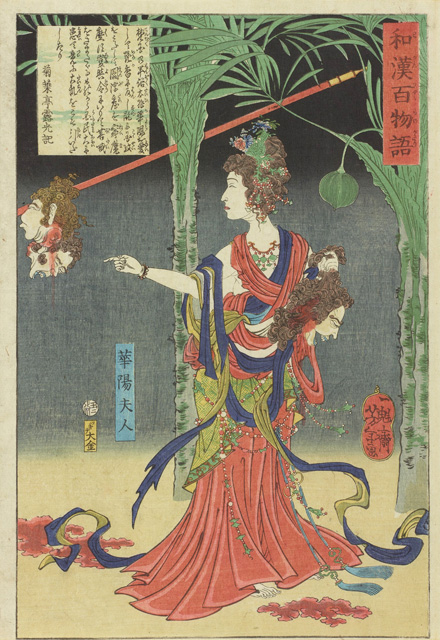
“One Hundred Ghost Stories of China and Japan : Lady Kayō”
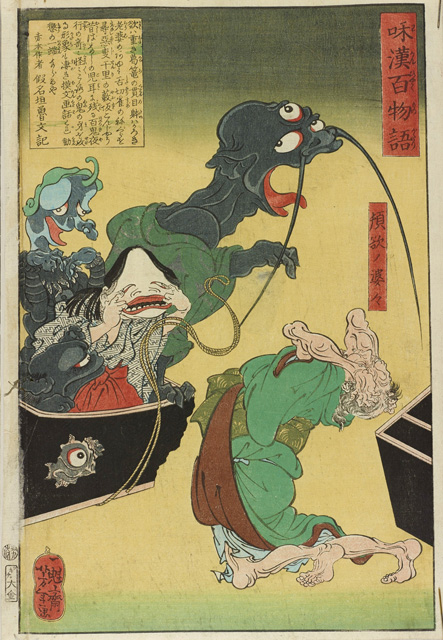
“One Hundred Ghost Stories of China and Japan : Insatiable Old Woman”
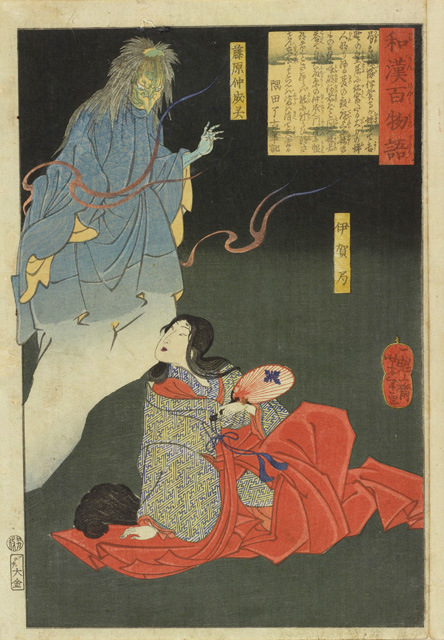
“One Hundred Ghost Stories of China and Japan : Iga-no Tsubone”
“New Forms of Thirty-six Ghosts” is a series of 36 pictures depicting specters, which was published from 1889 to 1892 in the Meiji period. Yoshitoshi was in his 51st year when its publication started, and some of the pictures were published after he died in 1892. It is literally a masterpiece of his latest years, and is also a compilation of the specter pictures which he had been working on for all those years. It is considered that the word “新形 shin-kei (new style) ” in the title is homophone of such as “神経 shin-kei (nerve) ” and “真景 shin-kei (actual scene) ” which were trendy words at the time.
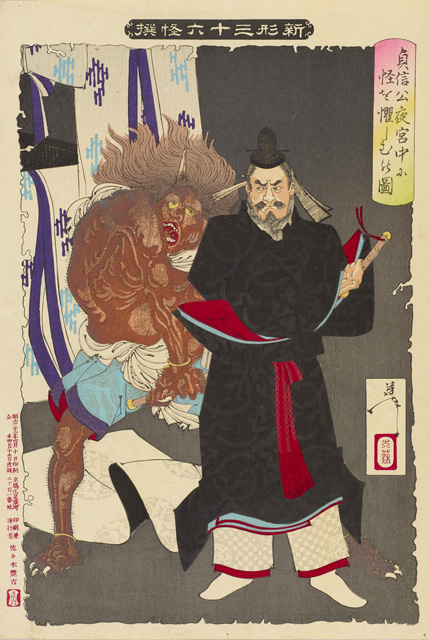
“New Forms of Thirty-six Ghosts : Lord Teishin Frightening an Ogre”
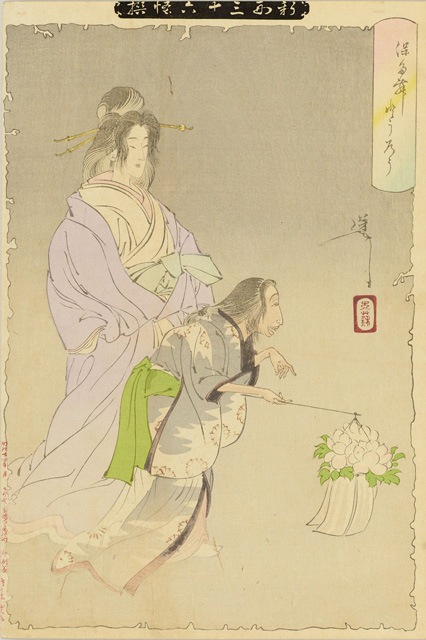
“New Forms of Thirty-six Ghosts : Female Ghost Visiting a Man”
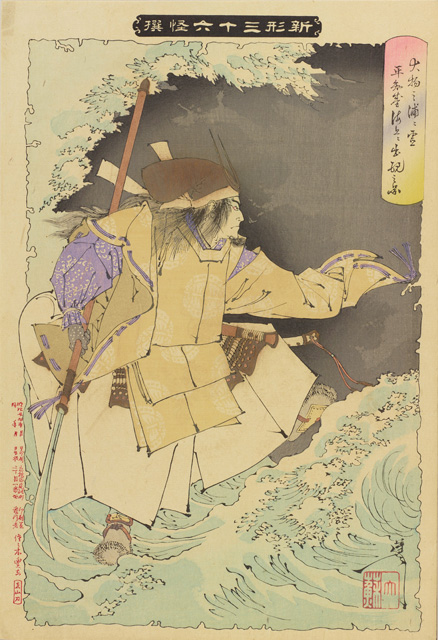
“New Forms of Thirty-six Ghosts : Ghost of Taira-no Tomomori Appearing at Daimotsu Bay”
<Highlight work of Exhibition>
“New Forms of Thirty-six Ghosts : Minamoto-no Yorimitsu Slashing at a Demon Spider”

This is a picture of Minamoto-no Yorimitsu hunting Tsuchigumo, which is based on a story from Tsurugi-no Maki (Book of Swords) of Tale of the Heike and Record of the Great Peace. One night while Yorimistu, a warrior of the Heian period, was attacked by a disease and lay sick in bed, a priest appeared out of nowhere, and tried to bind him with a rope. Yorimitsu was startled but quickly responded to slash him with his legendary sword “Hizamaru” that was kept at his bedside. His followers, the four guardians who were on night duty in a different room, also rushed to help him. As they hunted down the traces of blood, they found a giant spider (Tsuchigumo), and they bravely exterminated it. Yorimitsu’s legendary sword “Hizamaru” came to be called “Kumokiri” (to slash a spider) after this incident. In this powerfully composed picture, Yoshitoshi depicted the moment of Tsuchigumo, disguised as a priest, trying to bind Yorimitsu with a semi-transparent spider’s web, while Yorimitsu is about to draw his sword “Hizamaru”. The depiction of the yellow goggling eyes of Tsuchigumo is striking.
Admission
| Adult | 1000 yen |
|---|---|
| University and High school students | 700 yen |
| Junior High School Students and below | Free |
Calendar
Closed
-
-
-
2017 July
SUN MON TUE WED THU FRI SAT 1 2 3 4 5 6 7 8 9 10 11 12 13 14 15 16 17 18 19 20 21 22 23 24 25 26 27 28 29 30 31 -
2017 AugustSpecial Exhibition
SUN MON TUE WED THU FRI SAT 1 2 3 4 5 6 7 8 9 10 11 12 13 14 15 16 17 18 19 20 21 22 23 24 25 26 27 28 29 30 31
-
-
月岡芳年 月百姿
最晩年の代表作、「月百姿」全100点を一挙に公開
「月岡芳年 妖怪百物語」展(2017年7月29日~8月27日)に引き続き、幕末・明治の浮世絵師・月岡芳年の魅力を、さらに一歩掘り下げてご紹介いたします。今回展示するのは、芳年の最晩年の傑作である「月百姿」。「月百姿」はその題名の通り、全部で100点からなりますが、全点を一挙にご覧いただける機会はあまり多くありません。最後の浮世絵師とも称される芳年がたどり着いた境地を、まとめてご覧いただけるまたとない機会です。

月岡芳年「月百姿 朝野川晴雪月 孝女ちか子」

月岡芳年「月百姿 はかなしや波の下にも入ぬへしつきの都の人や見るとて 有子」
「月百姿」の世界を4つの切り口で鑑賞
「月百姿」は、月にちなんだ物語を題材としていますが、平安時代や戦国時代の武将たちや絶世の美女たち、あるいは幽霊や妖怪などの不可思議な存在まで、さまざまなテーマが登場します。そこで、本展では、①美しき女たち、②妖怪・幽霊・神仏、③勇ましき男たち、④風雅・郷愁・悲哀という独自の切り口を設けることで、「月百姿」の世界を分かりやすくご紹介いたします。月の綺麗な秋の季節、月にまつわるさまざまな物語をご堪能ください。

月岡芳年「月百姿 稲むらが崎の明ぼのの月」

月岡芳年「月百姿 烟中月」
100年以上前とは思えない! 斬新な構図・華麗な色彩
「月百姿」は明治18~25年(1885~92)、すなわち、今から約130年以上前に制作されました。しかしながら、大胆な視点から切り取った迫力ある構図や、月夜の静けさがしみわたるような静謐感、さらには粋を極めた彫りや摺りの美しさなど、現在の私たちでも「カッコいい!」「キレイ!」と口にしたくなるような新鮮な魅力にあふれています。芳年の「月百姿」の持つ“新しさ”にぜひご注目ください。

月岡芳年「月百姿 吼噦」

月岡芳年「月百姿 玉兎 孫悟空」

月岡芳年「月百姿 忍岡月 玉渕斎」

月岡芳年「つき百姿 盆の月」
<見どころの一点>
「つきの百姿 大物海上月 弁慶」

源義経たちが大物浦から船出をした際、にわかに暴風雨となり、壇の浦に沈んだ平家の怨霊たちが行く手をはばみました。しかし、弁慶は経文を唱えることで、見事、怨霊を退散させます。平家の怨霊の姿ははっきりと描かれていませんが、画面の多くを占める漆黒の海と、弁慶に襲いかかる不気味な波の動きで、見る人の不安をかきたてます。緻密に計算された、芳年ならではの迫力ある作品です。
芳年を巡る 入館料相互割引プラン
下記展覧会のチケットを当館でご提示いただくと、「月岡芳年 月百姿」展を100円割引でご覧いただけます。
※1枚につき1名様、1回限り有効、他の割引との併用はできません。
横浜市歴史博物館
丹波コレクションの世界Ⅱ 歴史×妖×芳年
2017年7月29日(土)~8月27日(日)
入館料
リピーター割引 「月岡芳年 妖怪百物語」および「月岡芳年 月百姿」両展覧会の会期中2回目以降ご鑑賞の方は、半券のご提示にて200円割引いたします。
※チケット購入時に半券をご提示下さい。他の割引との併用はできません。
| 一般 | 1000円 |
|---|---|
| 大高生 ※学生証をご提示ください。 | 700円 |
| 中学生以下 ※中学生は学生証(生徒手帳)をご提示ください。 | 無料 |
開館日カレンダー
休館日
-
2017年9月特別展
SUN MON TUE WED THU FRI SAT 1 2 3 4 5 6 7 8 9 10 11 12 13 14 15 16 17 18 19 20 21 22 23 24 25 26 27 28 29 30
